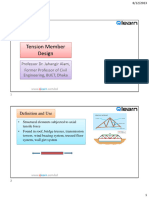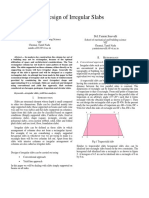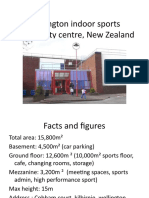Strength Design
Strength Design
Uploaded by
3C TrainingCopyright:
Available Formats
Strength Design
Strength Design
Uploaded by
3C TrainingOriginal Description:
Copyright
Available Formats
Share this document
Did you find this document useful?
Is this content inappropriate?
Copyright:
Available Formats
Strength Design
Strength Design
Uploaded by
3C TrainingCopyright:
Available Formats
3C-Engineering & Research
Center of Education and Consciousness
Address: House 18, Road 8, PC Culture Society, Sekhertek, Mohammadpur,
Contact: 01824810796 Email: 3ctrainingbd@gmail.com,
facebook.com/EngineeringTraining3C
Two design philosophies have long been prevalent:
• Allowable Stress Design
• Strength Design
General Note
• Members shall be designed for adequate strength in accordance with the provisions, using load factors
and strength reduction factors φ.
• Design of reinforced concrete members using Working Stress Design method (Appendix J) is also
permitted.
• Structures and structural members shall be designed to have design strength at all sections at least equal
to the required strength (U) calculated for the factored loads and forces in such combinations as are
stipulated in Chapter 2, Loads. The nominal strength provided for the section multiplied by the strength
reduction factor φ shall be equal to or greater than the calculated required strength U.
Required Strength (U) ≤ Design Strength
Required Strength = Combination of Service Load Effects × Respective Load Factors
Service Load = The load specified by the building code, which a structure is expected to support under normal
usage
Service Load Effects = Internal forces (axial force, shear force, bending moment, etc.) generated in a member by
the code-specified service loads, and determined using structural analysis
Load Factor = Factors to account for probable variations in service load (≥1.0)
Strength-Level Load = The maximum load that any structure is designed to support
Load factors scale the effects of the service loads on a structural member up to the effects of strength-level loads.
Design Strength = φ × Nominal Strength
φ = Strength reduction factor (≤1.0)
Nominal Strength = Strength of a member or a cross- section calculated using the assumptions and strength design
provisions of ACI 318M (BNBC 2020).
Both nominal strengths and φ-factors for reinforced concrete members are to be determined in accordance with
ACI 318M-08 (BNBC 2020)
Required Strength:
Pu = Factored axial force at section Vu = Factored shear force at sectionMu = Factored bending moment at section
Tu = Factored torsional moment at section
Nominal Strength:
Pn = Nominal axial strength at sectionVn = Nominal shear strength at sectionMn = Nominal flexural strength at
sectionTn = Nominal torsional moment strength at section
Design Strength:
φPn = Design axial strength at sectionφVn = Design shear strength at sectionφMn = Design flexural strength at
sectionφTn = Design torsional moment strength at section
Load Factors Account for:
1. Probable variation in specified service loads because of
• Variation in member sizes
• Variation in material densities
• Structural and nonstructural alterations
• Degree of accuracy in load determination
2. Uncertainties in calculation of load effects on a member because of
• Assumptions of stiffness, span length, etc.
• Other assumptions and simplifications in the structural model used for analysis
3C-Engineering & Research
Center of Education and Consciousness
Address: House 18, Road 8, PC Culture Society, Sekhertek, Mohammadpur,
Contact: 01824810796 Email: 3ctrainingbd@gmail.com,
facebook.com/EngineeringTraining3C
Strength Reduction Factor Account for:
1. Probable variation in material strength because of
• Quality control
• Effect of testing speed
• Difference between in-situ strength and specimen strength
• Stresses due to creep and shrinkage
2. Probable variation in member sizes because of
• Tolerances in formwork
• Rolling and fabrication tolerances allowed for reinforcing bars
• Tolerances in reinforcement placement
3. Various design assumptions and simplifications that cause the design behavior of structural members to
deviate from their actual behavior.
4. Consequences of failure.
• Members shall also meet all the other requirements to ensure adequate performance at service loads.
• Design strength of reinforcement represented by the values of f y & fyt used in design calculations shall not
exceed 550 MPa (79770), and for transverse reinforcement f y & fyt may exceed 420 MPa (60000 psi), only
if the ratio of the actual tensile strength to the actual yield strength is not less than 1.20, and the
elongation percentage is not less than 16.
• Minimum concrete strength for structural use of reinforcement concrete shall be 20 N/mm 2 (2900 psi).
However, for buildings up to 4 storey, the minimum concrete strength may be relaxed to 17 N/mm 2 (2500
psi)
Unified Design Provisions:
Strength Reduction Factor, φ,
Under Flexure and/or Axial Load
Depends on Net Tensile Strain, εt
Net tensile strain — The tensile strain at nominal strength exclusive of strains due to effective prestress, creep,
shrinkage, and temperature effects.
Extreme tension steel — The reinforcement (prestressed or nonprestressed) that is the farthest from the extreme
compression fiber.
Extreme tension steel — The reinforcement (prestressed or nonprestressed) that is the farthest from the extreme
compression fiber.
Unified Provisions Applicability
• Flexural & compression members
• R/C, P/S, and combinations
• Steel at various depths
• Sections of any shape
• Composite sections
• Tension-controlled columns
You might also like
- Storm Water Drain Priced BOQ Packages To VendorsDocument3 pagesStorm Water Drain Priced BOQ Packages To VendorsSureshNo ratings yet
- DBH Guide For Building Work Consent Not Required PDFDocument60 pagesDBH Guide For Building Work Consent Not Required PDFbenra1No ratings yet
- Tension Member Design: Professor Dr. Jahangir Alam, Former Professor of Civil Engineering, BUET, DhakaDocument32 pagesTension Member Design: Professor Dr. Jahangir Alam, Former Professor of Civil Engineering, BUET, DhakaS M Zillur RahamanNo ratings yet
- Sthapona Profile 09.04.2015Document30 pagesSthapona Profile 09.04.2015SohagNo ratings yet
- DEA Report of Ancillary BLDG PDFDocument33 pagesDEA Report of Ancillary BLDG PDFMd.Mizanur RahamanNo ratings yet
- Structural Design Concept PaperDocument4 pagesStructural Design Concept PaperUday Kumar Das100% (1)
- Short Resume of Khairul AlamDocument1 pageShort Resume of Khairul AlamKhandaker Khairul Alam100% (1)
- Background and Principles of D8 Consultants Ltd. (D8CL) PDFDocument7 pagesBackground and Principles of D8 Consultants Ltd. (D8CL) PDFJaher WasimNo ratings yet
- Paper ID: CBM 041: Construction Safety Practice in Bangladesh: A Case Study in KUET, Mirerdanga and Teliganti UnionDocument5 pagesPaper ID: CBM 041: Construction Safety Practice in Bangladesh: A Case Study in KUET, Mirerdanga and Teliganti UnionAhmed RolinNo ratings yet
- Dea-Report of Baridhara Dohs Building - 02 July 2019Document66 pagesDea-Report of Baridhara Dohs Building - 02 July 2019CEG BangladeshNo ratings yet
- Seismic Design of RC Structures 2Document15 pagesSeismic Design of RC Structures 2Wasimur rahmanNo ratings yet
- Structuiral Drawings of Revised PlanDocument28 pagesStructuiral Drawings of Revised PlanShantonu DeyNo ratings yet
- Impact Interior Studio Ltd. - CredentialDocument18 pagesImpact Interior Studio Ltd. - CredentialermNo ratings yet
- Column Input Data: No Area of Each ReinforcementDocument12 pagesColumn Input Data: No Area of Each ReinforcementMatiur Rahman BasumNo ratings yet
- Briefing On NIRAPON Directives & Challenges in Factory Safety Inspections & TrainingDocument9 pagesBriefing On NIRAPON Directives & Challenges in Factory Safety Inspections & TrainingMohammad Mizanur RahmanNo ratings yet
- LEC 1 Introduction (Converted)Document33 pagesLEC 1 Introduction (Converted)Tasbirul HussainNo ratings yet
- 18 Torsional Irregularity AsieDocument3 pages18 Torsional Irregularity Asiecivil.stl100100% (1)
- 3 Heave at Bottom of ExcavationDocument5 pages3 Heave at Bottom of ExcavationShantonu DeyNo ratings yet
- Earthquake Analysis BNBCDocument20 pagesEarthquake Analysis BNBCHAITHAM ALINo ratings yet
- Egger Pro Flooring Collection 2021+: Ideas For LifeDocument52 pagesEgger Pro Flooring Collection 2021+: Ideas For Lifeharitrathi94No ratings yet
- Torsional - Irregularity - Z01a01 - v3.4 - 11022020Document12 pagesTorsional - Irregularity - Z01a01 - v3.4 - 11022020Md. Moshiur RahmanNo ratings yet
- 01.09.2023 Sheet Pile Quotation BOQDocument4 pages01.09.2023 Sheet Pile Quotation BOQSimul DeyNo ratings yet
- Minimum Development and Splice Lengths (MM)Document2 pagesMinimum Development and Splice Lengths (MM)zakaria200811060No ratings yet
- PROJECT: Janathon Bonik, Dhaka Savar: by Engr. Ali AsgorDocument9 pagesPROJECT: Janathon Bonik, Dhaka Savar: by Engr. Ali AsgorMehedi H. RanaNo ratings yet
- Long Column - ModifiedDocument4 pagesLong Column - ModifiedMd. Moshiur RahmanNo ratings yet
- Business Policy and Strategic AnalysisDocument19 pagesBusiness Policy and Strategic Analysisheena1630No ratings yet
- SETTLEMENT Modified For MATDocument69 pagesSETTLEMENT Modified For MATbeleteNo ratings yet
- Vat & Tax CalculatorDocument6 pagesVat & Tax CalculatorRoyNo ratings yet
- Company Profile of Arman EngineeringDocument37 pagesCompany Profile of Arman Engineeringashrafur_chowdhuryNo ratings yet
- Modern Sports ComplexDocument33 pagesModern Sports ComplexRezwanul IslamNo ratings yet
- CE 6172: Vibration Control of Structures: Raquib Ahsan, Ph.D. Professor, Dept. of Civil Engineering BuetDocument25 pagesCE 6172: Vibration Control of Structures: Raquib Ahsan, Ph.D. Professor, Dept. of Civil Engineering BuetRaquib AhsanNo ratings yet
- Tda ProfileDocument8 pagesTda ProfileZubair MohammedNo ratings yet
- Raising Boundary Wall Gate 3 To 4Document6 pagesRaising Boundary Wall Gate 3 To 4sharif uddinNo ratings yet
- CV Sajoyan Haque Inditex Arup Nec CuetDocument2 pagesCV Sajoyan Haque Inditex Arup Nec CuetSajoyan HaqueNo ratings yet
- Seismic Structural EngineeringDocument11 pagesSeismic Structural EngineeringMuhammad AbubakarNo ratings yet
- Combined Footing DesgnDocument14 pagesCombined Footing DesgnKhalid RehmanNo ratings yet
- Alokdhara January.2012Document52 pagesAlokdhara January.2012Muhammed Moyeen Uddin Bhuiyan100% (1)
- Soil Site Class For Earthquake AnalysisDocument8 pagesSoil Site Class For Earthquake AnalysisMd Rashedul IslamNo ratings yet
- Presentation On High Rise BuildingDocument17 pagesPresentation On High Rise BuildingAtiq R RafiNo ratings yet
- Shear Waal Rebar CheckDocument2 pagesShear Waal Rebar Checkcivil.stl100No ratings yet
- Wind Load Calculation From A. Rashid SirDocument6 pagesWind Load Calculation From A. Rashid Sirabdullah rahmanNo ratings yet
- 09 Flexure in Beams 01Document25 pages09 Flexure in Beams 01S. M. ZAHIDUR RAHMAN 1301129No ratings yet
- Training On - Infill Masonry Wall - 30.01.2021Document46 pagesTraining On - Infill Masonry Wall - 30.01.2021Khandaker Khairul AlamNo ratings yet
- Maize and Tomatoes PlotsDocument1 pageMaize and Tomatoes PlotsNiborugero VedasteNo ratings yet
- Appendix C - Seismic Design Parameters BNBC 2020 CommentaryDocument2 pagesAppendix C - Seismic Design Parameters BNBC 2020 CommentaryTarif Aziz MarufNo ratings yet
- Design of Irregular SlabsDocument5 pagesDesign of Irregular SlabsEngr. Md. Mahmdudul Hasan ShawonNo ratings yet
- Introduction - Types of BuildingDocument15 pagesIntroduction - Types of BuildingOmar SakibNo ratings yet
- Wind Load Analysis Exp-A 15-09-2016Document14 pagesWind Load Analysis Exp-A 15-09-2016zakaria200811060No ratings yet
- Cost Analysis Sheet - Option 1.Document2 pagesCost Analysis Sheet - Option 1.AB Rakib AhmedNo ratings yet
- Cst-In-Situ Pile Nafa Apparels Unit-1Document9 pagesCst-In-Situ Pile Nafa Apparels Unit-1Md. Moshiur Rahman100% (1)
- Meridional Stress Hoop Stress Angle Duetow Due To W Total DuetowduetowtotalDocument2 pagesMeridional Stress Hoop Stress Angle Duetow Due To W Total DuetowduetowtotalMuhammed SabahNo ratings yet
- Pile Cap DesignDocument75 pagesPile Cap Designg s venkata subramaniNo ratings yet
- EQ Analysis BNBC-2017, ASCE 7-05, ASCE 7-10Document15 pagesEQ Analysis BNBC-2017, ASCE 7-05, ASCE 7-10Shajib RezaNo ratings yet
- SSD W.A. DRY 6 Cubes 0.027Document13 pagesSSD W.A. DRY 6 Cubes 0.027Amit MaityNo ratings yet
- "Effect of Corrosion On RC Building": "Tanhavi Gajbhiye"Document28 pages"Effect of Corrosion On RC Building": "Tanhavi Gajbhiye"TanviNo ratings yet
- Abir Fashion. - 08.02.17 PDFDocument240 pagesAbir Fashion. - 08.02.17 PDFMd.Mizanur RahamanNo ratings yet
- BSPP - Training MaterialsDocument410 pagesBSPP - Training MaterialsMegadeth ShawonNo ratings yet
- Building Information Owned/RentedDocument59 pagesBuilding Information Owned/RentedMollickNo ratings yet
- Raft ThicknessDocument6 pagesRaft ThicknessmanpreetkhanujaNo ratings yet
- Concrete DesignDocument8 pagesConcrete DesigncherogonyaNo ratings yet
- Design of An Industrial Shed Using Prestressed ConcreteDocument8 pagesDesign of An Industrial Shed Using Prestressed ConcreteSasi HoneyNo ratings yet
- Design BookDocument53 pagesDesign BookmollikaminNo ratings yet
- Electrical Layout-Sports FacilityDocument2 pagesElectrical Layout-Sports FacilityPatty GorospeNo ratings yet
- Air Conditioning System Jobsite Information Sheet: Owner Date Requested: RequestorDocument2 pagesAir Conditioning System Jobsite Information Sheet: Owner Date Requested: RequestorYogesh ThackreyNo ratings yet
- Method Statement For HVAC Ductwork Insulation and Acoustic LiningDocument4 pagesMethod Statement For HVAC Ductwork Insulation and Acoustic Liningamg00750% (4)
- Ecfn Aus Ci 0100 Spe 01005 (C PDF)Document30 pagesEcfn Aus Ci 0100 Spe 01005 (C PDF)Janeth MeraNo ratings yet
- BOQ - Bill BageDocument16 pagesBOQ - Bill BageSinthuja DilanNo ratings yet
- Estimation and PlanningDocument151 pagesEstimation and Planningfirojji panchtilakNo ratings yet
- TimberhavenLogHomes BrochureDocument16 pagesTimberhavenLogHomes BrochureHectorGabrielLinerosHenriquezNo ratings yet
- Gebe005 Aug08 PDFDocument22 pagesGebe005 Aug08 PDFأسامة خالدNo ratings yet
- DAB Modified FinalDocument74 pagesDAB Modified FinalFreedom Love Nabal100% (1)
- Wellington Indoor Sports Community Centre, New ZealandDocument27 pagesWellington Indoor Sports Community Centre, New ZealandSabita BasnetNo ratings yet
- Pre-Stressed Concrete PDFDocument75 pagesPre-Stressed Concrete PDFUmer WaheedNo ratings yet
- NewDocument97 pagesNewĢI ĢINo ratings yet
- CCECC MAX DCRP BR 18 F 0062 General Method StatementDocument140 pagesCCECC MAX DCRP BR 18 F 0062 General Method StatementArman ShohelNo ratings yet
- Moment FramesDocument49 pagesMoment FramesHariniNo ratings yet
- Experimental Investigation of Pervious Concrete ToDocument11 pagesExperimental Investigation of Pervious Concrete ToraheelNo ratings yet
- Review Report On ES en (New Code)Document166 pagesReview Report On ES en (New Code)Zereyakob Ketsela100% (1)
- Beam Renforcing Bar Dia12 Colon Reinforcing Bar Dia 1Document7 pagesBeam Renforcing Bar Dia12 Colon Reinforcing Bar Dia 1kinfe haileNo ratings yet
- Sandwitch PanelsDocument21 pagesSandwitch Panelssabah morsiNo ratings yet
- Slot - 2 - DCR Abhisek 15th JanDocument26 pagesSlot - 2 - DCR Abhisek 15th Janabhisekkoyal334No ratings yet
- Structville Programme of WorksDocument1 pageStructville Programme of WorksVictor OmotoriogunNo ratings yet
- Application Form / Checklist : Department of Fire & Rescue Services, Government of KeralaDocument37 pagesApplication Form / Checklist : Department of Fire & Rescue Services, Government of KeralaStew884No ratings yet
- STRUCT Beachfront ADocument6 pagesSTRUCT Beachfront ALorenz Carlo Robedillo GonzalesNo ratings yet
- IGBC Green Interior CasestudiesDocument18 pagesIGBC Green Interior CasestudiesTejasNo ratings yet
- List of BIS StandardsDocument9 pagesList of BIS StandardsKumar100% (1)
- TS-03 Air Distribution WorksDocument14 pagesTS-03 Air Distribution WorksPraveen KumarNo ratings yet
- Front Elevation: ExistingDocument1 pageFront Elevation: ExistingAce LangNo ratings yet
- DETAIL COMP WALL-Model PDFDocument1 pageDETAIL COMP WALL-Model PDFjitendraNo ratings yet
- Is 2212 1991Document29 pagesIs 2212 1991Gotcha148No ratings yet

























































































